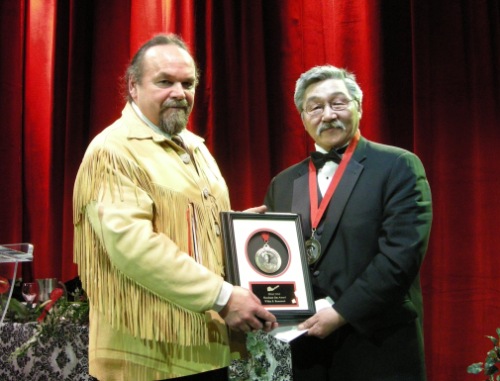 The PDAC Skookum Jim Award is named after Skookum Jim, the Aboriginal leader of the group that discovered the Yukon Klondike goldfields, one of Canada’s most important mineral discoveries. Recipients of this award will have demonstrated exceptional achievement and/or service in a Canadian Aboriginal-run service business for the Canadian mining industry or a Canadian aboriginal exploration or mining company or made a significant individual contribution to the mineral industry either technically, through a business venture, or through a mineral discovery.
The PDAC Skookum Jim Award is named after Skookum Jim, the Aboriginal leader of the group that discovered the Yukon Klondike goldfields, one of Canada’s most important mineral discoveries. Recipients of this award will have demonstrated exceptional achievement and/or service in a Canadian Aboriginal-run service business for the Canadian mining industry or a Canadian aboriginal exploration or mining company or made a significant individual contribution to the mineral industry either technically, through a business venture, or through a mineral discovery.
Willie S. Keatainak is recognized for his key role in negotiating the Raglan Agreement, encouraging others to take advantage of the opportunities that the Raglan mine offers, and his longstanding involvement in Nuvumiut Developments, an Inuit community-based company serving the mining industry.
Keatainak is on a mission to better the lives of his people, the Inuit living in communities in far northern Quebec, especially those in his home village of Salluit, situated on the northern tip of the Ungava Peninsula.
In the early 1990s, as the mayor of Salluit, Keatainak acted as the chief negotiator on a team seeking long-term economic stability for Inuit communities through the development of Falconbridge Ltd.’s Raglan nickel depostis, emplaced in the nearby Cape Smith-Wakeham Bay ultramafic belt.
The Raglan negotiations took about four years and, in 1995, Keatainak and others signed an historic Impact Benefits Agreement with Societe miniere Raglan du Quebec, a wholly owned Falconbridge subsidiary. Known as the Raglan Agreement, it was the first of its kind in Canada and formed a template for many similar agreements.
The Raglan Agreement includes profit sharing with the communities of Salluit, Kangiqsujuaq, and Makivik Corp.
In 2007, with nickel prices soaring, the Raglan operations, now owned by Swiss firm Xstrata Plc., shared about $32 million in profits with Inuit communities.
The agreement further requires Xstrata to annually fund an Inuit trust through Makivik Corp. Xstrata’s total fund contributions could exceed $70 million over Raglan’s mine life.
Qualified Inuit in the communities of Salluit and Kangiqsujuaq are given preferred status for available jobs. The agreement states that 20% of Raglan’s 700 employees should be Inuit.
The employment and training aspects of the Raglan Agreement are implemented through the Raglan Employment and Training and Technical Committee.
When mining started at Raglan in 1997, Keatainak was an employment and training officer responsible for hiring, training and the orientation of Raglan’s Inuit staff.
He was well suited for the task, having worked for Asbestos Corp. In the early 1970s as a general labourer, mucker and heavy equipment operator at the Asbestos Hill mine.
Keatainak trained Inuit employees through Nuvumiut Developments, a company that aims to secure economic development opportunities at Raglan.
These days, as President of Nuvumiut Developments, Keatainak is working with joint-venture partners to take advantage of the preferred status given to Inuit contractors when the bidding opens on Raglan contracts.
Nuvumiut’s first joint-venture partnership was formed in 1995 with construction and engineering firm Kiewit.
The Kiewit-Nuvumiut joint venture started during Raglan’s construction but with Nuvumiut receiving only 20% of revenue. Under a revised partnership agreement, revenue is now split down the middle.
Another joint venture, Bradley-Nuvumiut, was formed in 2002 between drilling firm Bradley Bros. Ltd. And Nuvumiut Developments. Bradley Nuvumiut has 14 surface diamond drills and two underground rigs. The joint venture offers a driller training program designed to encourage Inuit to enter the industry.
In 2008, Bradley Nuvumiut signed a five-year contract with Xstrata for at least 450,000 metres of surface drilling at Raglan. It is thought to be the largest drilling contract ever signed with an aboriginal enterprise.
Nuvumiut operates similar joint ventures with mining contractor Redpath and environmental firm Jacques Whitford.
Nuvumiut Developments began in 1996 with $160,000 and now has assets worth about $15 million. Keatainak helped ensure, however, that the Raglan Agreement was about more than economic opportunities.
Raglan sits on a watershed that supplies fresh water to Salluit and Kangiqsujuaq. During negotiations, one of Keatainak’s biggest concerns was mining’s impact on the area’s water supply.
The Raglan Agreement established the Raglan Committee, consisting of one seat each for Salluit, Kangiqsujuaq and Makivik, and three seats for Xstrata, to oversee regular environmental studies and to ensure the implementation of the agreement.
The work spearheaded by Keatainak on the landmark Raglan Agreement has indeed improved the lives of his people and will continue to for many years to come. Mission accomplished.























